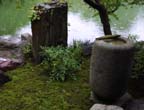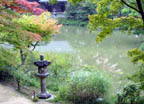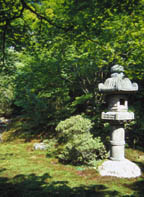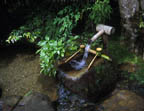Lanterns and Basins
Although some recent texts on Japanese gardens state that stone or bronze lanterns were first used to light the paths of tea gardens, these elements appeared in Japanese gardens, temple compounds, Shinto shrines, and other venues long before the development of the tea ceremony. They are often placed near water basins, at the end of peninsulas, and near the entrances to important buildings. Stone lanterns come in a variety of shapes and sizes, although there are certain traditional types that appear often and have specific names. Great value is placed upon antique examples. Some gardens make no use of this element, while others like that of Katsura can have as many as twenty to thirty lanterns.
Many religions, including Shinto and Buddhism, require a ritual cleansing before one is allowed into a holy sanctuary. In Japan this usually means pausing at a water basin and using a bamboo dipper to rinse the hands and mouth. In gardens built on the grounds of a Buddhist temple, the basin can take one of many forms, from a highly crafted bronze basin to an unworked boulder with a natural depression. The dipper often rests upon two lengths of bamboo tied with black silk cord. Because the tea ceremony has certain ritual associations, tea house gardens usually include a basin, and even private gardens may contain this element.
| (click thumbnail for larger image) | return to Elements |
||
 |
|||
| Byodo-in | Joruri-ji | Kenroku-en | Konchi-in |
 |
 |
||
| Shoren-in | Kinkaku-ji | Shusui-tei | Ryoan-ji |
 |
|||
| Honen-in | Private Garden | Private Garden | Taizo-in |







